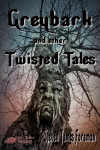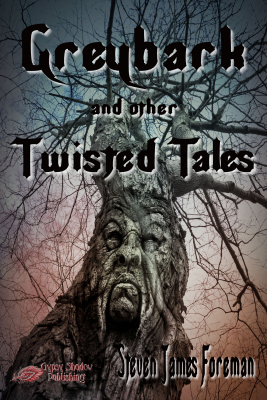Steven James Foreman

|
Steve is British and has lived in Africa for more than 20
years. He works in mainly conflict affected regions as a
top-level Security and Risk Manager/Consultant.
WEBSITE: https://bushleader.wordpress.com/
FACEBOOK:
https://www.facebook.com/profile.php?id=100010379619944
BLOG: https://bushleader.wordpress.com/ |
New Title(s) from Steven James Foreman

Order The Greybark Print Book Today!
Click on the thumbnail(s) above to learn more about the book(s) listed.

|
Greybark is a collection of published short
stories that previously appeared in both print and online
publications, all brought together now in one book. Here you
will find short stories of horror and hauntings, tales of
strange beings and vampires and talking trees, accounts of death
and destruction, fatal encounters with ghosts and monsters and
mythical creatures, and crime mysteries with unexpected twists
in the tales. This is a book to keep by your bedside for a quick
read before lights out, or to take with you when travelling, to
dip into at random whenever you have half-an-hour to fill or do
not have the time to read a full-length novel. Don’t leave home
without it!
Several of the stories in this book originally appeared in the
anthologies Beneath the Surface and Trips to the Dark Side, both
published by Gypsy Shadow Publishing and currently out of print.
Beneath the Surface was voted third out of the 64 books
considered by the Preditors and Editors Poll 2012 in the
Anthologies category.
Excerpt
Word Count: 94770
Buy at:
Smashwords (all formats) ~
Barnes and Noble ~
Amazon
Price: $ 5.99
|
 |
Order Greybark and other Twisted Tales in Print today!
(ISBN: 978-1-61950-331-1)
|
| |
|
| Excerpts |
Greybark and other Twisted
Tales |
Greybark
First published in Aphelion Magazine (2014)
Sara straightened up from loading the dishwasher, tucked a
strand of loose blonde hair back into her headscarf and looked
out the kitchen window of their new house. At the bottom of the
long back garden, just inside the fence, stood a huge old oak
tree, and standing next to it Sara could see her five-year-old
daughter, Penny, dressed like a tomboy in denim jeans and
wearing Bubblegum trainers. The girl’s lips were moving, and she
appeared to be talking to someone, but, as Sara would have
expected, there was no one else around. The few neighbours who
had so far moved into the other new houses nearby had no
children of Penny’s age, and at present, Penny was an only
child.
Sara wondered if Penny had suddenly got an imaginary friend. She
had heard that such playmates were often conjured up by
children—especially those who had no siblings.
She said nothing to Penny when the girl came in a short while
later, but made a mental note to keep an eye on this
development.
A few days later, when Sara went out into the afternoon sun to
hang clothes on the washing line, she actually heard Penny
speaking. The words were faint and lisping—not quite a whisper,
but slightly secretive. Sara feigned fussing with the laundry
basket and clothes pegs as she kept an eye on her daughter. The
girl appeared to be having a one-sided conversation. Sara
dropped her husband’s shirt back into the basket and strolled
over to her daughter. As she approached, Penny glanced around
and fell silent.
“Hi, baby,” said Sara in a light-hearted tone. “I thought I
heard you speaking. Who were you talking to?”
“No one, Mummy,” the girl replied. “Just playing with my dolls,
that’s all.”
“Oh, okay, darling, come on, come and wash your hands. There are
some milk and cookies on the kitchen table.”
Sara mentioned this development to David, her husband, when he
came home from the city that evening.
“I am sure it’s nothing,” David responded, as he sat down in an
armchair and shook open a copy of The Financial Times. “I have
heard about imaginary friends before. It’s just a phase that
will pass, I am certain.”
Over the next few weeks, however, Sara became increasingly
concerned about the amount of time Penny spent at the bottom of
the garden in the afternoons after she came home from
kindergarten, talking to her imaginary friend.
zzz
The fence at the bottom of Sara and David’s garden separated
their 50-metre manicured lawn from a huge area of deep deciduous
woodland that stretched away left and right for several miles.
Named Hartdown Woods, not long before scores of trees along the
fringes of the woods had been cut back to make way for the
twenty new detached houses now lined up along Hartdown Drive.
David, a fairly wealthy property developer, had not only built
the houses, he had set one aside for himself; his family was the
first to move into Hartdown Drive. Even now, several of the
other houses were still vacant and up for sale.
The only exception to the woodland clearance along the rear
boundaries of the twenty houses was the huge oak tree. The tree
was spared because of its great size and age, and because it
straddled the plot survey line. David had decided rather than
cut it down or reduce the size of the plot—thereby altering the
value of the land—his building contractors would dog-leg the
chain-link fence behind it, and therefore the tree stood within
their back garden.
zzz
“I am really getting worried about this,” Sara confided to her
husband one evening. “I mean, it is not just that she has an
imaginary friend; as you said, a lot of kids have those, but
Penny seems to be becoming secretive, and when I ask her about
her friend, she becomes silent and sullen.” Sara frowned. “And I
have only ever seen or heard her talking at the bottom of the
garden… never in the house or in her bedroom.”
“Well,” David responded. “Let’s have a word with her
kindergarten teacher at school; see if she has noticed
anything.”
The next day, instead of Sara just dropping Penny off at the
school gates, David took the morning off work and accompanied
her, and he and Sara went into the school offices where they
asked to speak with Penny’s teacher, Miss Spencer.
“No, I have never seen Penny having any one-sided
conversations,” the teacher replied to Sara’s question. “She is
just a normal, happy little girl, with plenty of playmates in
class. But if you are really worried, we have a school
counsellor you could speak to. She is a qualified psychologist.”
David and Sara glanced at each other. “I don’t know,” David
said. “A psychiatrist? It seems a bit extreme.”
Miss Spencer gave a reassuring laugh. “Doctor Jane Archer is not
a psychiatrist!” she shook her head gently. “She is a student
counsellor with a degree in psychology. So do not be alarmed.
She will be able to explain better about an imaginary friend and
the effect it has on a child.”
So David and Sara agreed, and Miss Spencer led them down the
corridor to Doctor Archer’s office.
“Imaginary companions are an integral part of many children’s’
lives,” Jane Archer explained, once David and Sara were seated
and had outlined their concerns to her. “They provide comfort in
times of stress, companionship, someone to boss around when they
feel powerless, but often they can be a role-model or an idol.
Most important, an imaginary companion is a tool young children
use to help them make sense of the adult world. So, your child’s
best friend may look just like her, eat the same foods, and
share the same interests.” Jane paused for a moment.
“While some child development professionals still believe that
the presence of imaginary friends past early childhood signals a
serious psychiatric disorder,” Jane explained and smiled
reassuringly, “I firmly believe that is not the case with
Penny.”
“You mean some kids who have imaginary friends can become
psychopaths?” Sara asked, sitting forward with a worried frown
upon her face.
“No, I didn’t say that, Sara,” Jane replied.
“I think I understand,” David interjected, “but from what my
wife has seen, this
imaginary friend only seems to surface in our back garden. Even
her teacher, Miss Spencer, says that she has never seen Penny
interact in class with anything or anyone invisible.”
“Well, maybe she only needs the friend when she is lonely… or
should I say, alone,” Jane glanced at Sara, who was about to
protest at the word lonely. “In other words, she gets enough
companionship at kindergarten and from her parents in the home,
but just needs a playmate when she is alone in the back garden.”
“I guess that could be it,” David muttered, leaning forward and
staring at his feet.
“Look,” Jane continued, brightly, “if you are still
uncomfortable about Penny having an invisible friend, you should
take comfort in knowing that research has consistently shown
that kids actually know these friends are not real and that they
will outgrow their need for such companionship with time. You
can determine whether you want to go along with Penny’s
imaginary friend or not, just by letting the friendship continue
on its own course, to the point where Penny may even discuss the
friendship with you, what they played or said to each other, as
she would if it were a real friend from kindergarten; she may
even tell you the friend’s name or something about him or her…
but you should not be insistent about Penny not pretending to
have such a friend, or you could create stress and turmoil for
her.”
With all this information at hand, David and Sara decided to
follow Jane Archer’s advice, and let things run their course.
Only a few days later, one afternoon when Sara was in the garden
clipping some flowers for the dining table vase, she heard Penny
raising her voice. She spun around in time to see Penny stamping
her foot petulantly and wagging her finger.
“No, it is not fair, it is not their fault!” Penny shouted and
burst into tears.
Sara dropped her pruning clippers and ran down the lawn to where
Penny stood sobbing. She swept the child into her arms, soothing
and comforting as only a loving mother could. “There, there,
baby. Whatever is the matter?” She smoothed the child’s hair.
“What is wrong, Penny?”
Penny’s sobbing subsided under the warm embrace of her mother.
Still choking back tears, the girl replied. “He said he wanted
to hurt you and daddy, ’cos you took his friends away from him!”
Sara carried her daughter back to the house and sat down next to
her on the sofa in the living room.
“Who said he wanted to hurt us, baby? Who were you talking to?”
“Greybark. His name is Greybark.”
“Penny, darling, is Greybark your imaginary friend? The one I
have heard you speaking to, is that who you mean?”
“No Mummy, Greybark is the big tree. He talks to me.” The girl’s
chest heaved twice; the air catching in the back of her throat,
as the final sobs faded.
Sara clamped a hand to her mouth to hold back a cry. She
breathed in and out heavily for a few moments before regaining
her composure.
Sara fetched a glass of water from the kitchen, passed it to her
daughter and then picked up the phone nearby.
“David? Are you able to leave work early and come home? I am
worried about Penny.”
“What’s wrong, is she sick?” David’s voice was concerned.
“No… well, not really. It’s this imaginary friend of hers. There
has been—a development. I cannot explain on the phone, but you
need to be here to hear this.”
|
Back to Greybark
|
| |
| |
| top |
|
